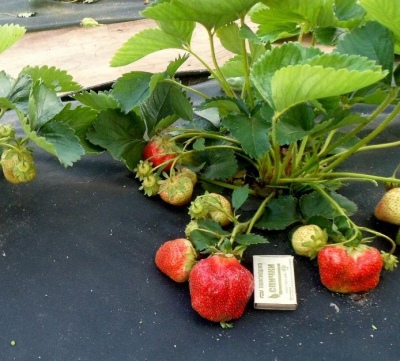
- Authors: Canada
- Name synonyms: Cabot
- Taste: raisin
- The size: very large
- Weight: the weight of individual specimens reaches 120-150 grams
- Yield rate: high
- Ripening terms: late
- Advantages: long shelf life
- Appointment: fresh consumption
- Description of the bush: squat, spreading
The Cabot strawberry was first developed in Canada. Then she was loved in all countries of the world for the amazing taste and large size of the fruit.
Description of the variety
The bushes of this berry variety are very spreading, but not high. The flower stalks are powerful. They are located below the foliage and bend under the heavy weight of large fruits.
This variety is mainly consumed fresh. It is not often grown for sale, as many doubt the natural origin of such a large berry, believing that various chemicals are used in fertilizers. This is not true, as thousands of summer residents who use Cabot for growing in their garden have seen.
Ripening terms
Cabot strawberries ripen late, so the variety itself is late. But flowering occurs in March-April.
Growing regions
Suitable for growing in all climates. Unlike other strawberry varieties, it can grow in the northern regions. Possesses high winter hardiness, but loves sunny areas. Therefore, in regions with a warm climate, it will give a higher yield.
Yield
It has a high yield - up to 1 kg of berries from one bush. The variety is also perfectly adapted to transportation and long-term storage.
Berries and their taste
The berries of this variety have a deep red hue and have a very large weight - about 120-150 g. No more than 2 berries can fit in the palms of a small child. The fruits have a conical shape and a ribbed surface. The taste is rich, sweet, vaguely reminiscent of raisins. The pulp has a fairly dense structure, but at the same time it is not too hard. Thanks to all these properties, the fruits are very popular with both gardeners and consumers.
Growing features
When placing bushes for planting, it must be borne in mind that this variety requires a distance between seedlings of more than 30 cm.This is necessary for placing leaves and powerful peduncles.
If even a small number of weeds appear, they must be removed immediately, as they draw out nutrients from the soil, which strawberry bushes need to form a good harvest. For planting, it is better to use sunny areas.




Site selection and soil preparation
Cabot strawberry is a rather unpretentious variety. Almost any soil is suitable for planting it, except sandy. Groundwater should not flow too close to the surface. Otherwise, the construction of an additional drainage layer will be required.
Before planting, they dig up the soil, removing plant residues from it. When planting strawberries, fertilizers are used. After planting, the bushes are best covered with needles or sawdust, and also covered with agrofibre to prevent weeds.

Pollination
The flowers are bisexual, so the plant pollinates itself. Additional pollination is not required.
Top dressing
For a timely and good harvest, you can use top dressing. One of the most suitable nitrogen fertilizers is nitroammophoska. Its use is described in the instructions attached to it. From organic fertilizers, manure and chicken droppings are used. But the droppings are usually too concentrated, so it is diluted with water. And also strawberry cabot reacts positively to mulch. It is widely used by gardeners and summer residents.

One of the important techniques in strawberry care is feeding. Regular fertilization guarantees a rich harvest. There are several different ways to feed strawberries, and each of them is designed for a specific period of plant development. During flowering, fruiting and after it, feeding should be different.

Diseases and pests
It is a very disease-resistant berry variety. However, it is prone to gray mold. To prevent its appearance, before planting, the roots of the plant are treated with an aqueous solution of potassium permanganate.
Against pests, the bushes are treated with biological products. For example, "Aktofit". Since biological agents are useless against insect larvae, two treatments are carried out with a difference of 5 days. And also you need to observe the temperature regime when working with these drugs.

Strawberries are often subject to many dangerous diseases that can seriously undermine its condition. Among the most common are powdery mildew, gray mold, brown spot, anthracnose, and verticillosis. Before buying a variety, you need to inquire about its disease resistance.
Reproduction
This berry variety develops a very small number of whiskers and one could say that it is not suitable for breeding. But due to the fact that they are very strong and thick, this species can be bred well with proper care.
Cabot Strawberry is a very large, juicy and tasty berry. For this she is appreciated.And also it is very easy to care for and is in demand even among beginners.



















































































